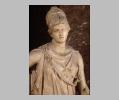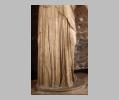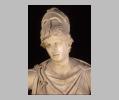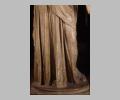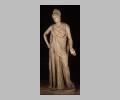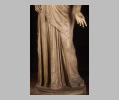| Collection: | Paris, Musée du Louvre |
| Title: | Mattei Athena |
| Summary: | Helmeted Athena with extended arm |
| Material: | Marble |
| Sculpture Type: | Free-standing statue |
| Category: | Original/copies |
| Style: | Late Classical |
| Technique: | In-the-round |
| Original or Copy: | Copy |
| Original: | Piraeus Athena |
| Dimensions: | H 2.30 m |
| Scale: | Over life-size |
| Period: | Roman? |
Subject Description:
Statue of Athena known by the name of the collection to which it once belonged, or sometimes as the Athena Pacifique. Though for years she was the only known example of this type, her style had led scholars to assume she was a copy of a classical statue of the 4c BC. The 1959 discovery of a cache of bronzes in the Piraeus included an Athena so close in scale and detail to the Mattei that it now appears to be the archetype from which the Mattei was derived. If this assumption is correct, the Piraeus bronze provides a correct restoration of the missing fragments of the Mattei and helps to explain a few stylistic anomalies of the statue which had appeared troublesome. Waywell published a short study of the Mattei which examines the divergencies from the bronze statue and seeks to explain them.
Athena faces forward, weight on the right leg, left leg relaxed and foot slightly back, breaking the vertical fall of the drapery on the back and left sides. Her left arm is bent and held somewhat apart from the body. In the modern restoration the hand is open to the viewer, in an unexplained gesture. Waywell has shown, however, that the arm parallels that of the Piraeus Athena insofar as it is preserved and in all probability copied it fully, i.e. the hand turned inward, grasping a spear and/or a shield. The right arm, however, has been intentionally altered by the copyist. Waywell suggests that the extended position of the arm in the bronze Athena could not be reproduced in marble without the addition of an awkward support and that the hand-on-hip pose was adopted as an economical alternative. That the pose changes the essential character of the image was evidently not a factor of great importance to the copyist. The only other differences concern the more pronounced turn of the head of the Mattei, which Waywell again attributes to an incorrect restoration (the break on the right side of the neck is not clean), and the substitution of rams' heads for the owls on the cheek pieces of the helmet, an unexplained change but a rather minor detail.
Form & Style:
The Piraeus Athena, and thus by inference the Mattei Athena, is sometimes attributed to Euphranor on the strength of its similarity to the Apollo Patroos (
Date Description:
Waywell dates the Mattei Athena itself to ca. 130-90 BC, on the assumption that such scale copies were not made in Athens before the period of Roman control in Greece (beginning in 146 BC) and that it should predate Sulla's sack in 87/86 BC, when the Piraeus Athena, presumably its model, was apparently removed from its original location and was lost. He dates the Piraeus Athena, archetype of the Mattei, to ca. 475 BC on the basis of style. See further notes under subject.
Condition: Nearly complete
Condition Description:
Modern restorations include: left hand and wrist (probably wrongly restored), fingers of right hand excluding the thumb, right side of neck, underside of chin, some hair at back, crown of helmet, area above left eye, lower end of cheek pieces, nose.
Material Description:
Parian marble (Waywell)
Technique Description:
Apparently a copy to scale in marble of the bronze statue of Athena found in the Piraeus.
Sources Used:
